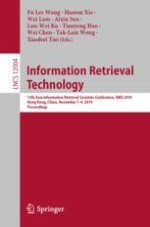2020 | Book
Information Retrieval Technology
15th Asia Information Retrieval Societies Conference, AIRS 2019, Hong Kong, China, November 7–9, 2019, Proceedings
Editors: Fu Lee Wang, Haoran Xie, Wai Lam, Dr. Aixin Sun, Lun-Wei Ku, Tianyong Hao, Wei Chen, Tak-Lam Wong, Xiaohui Tao
Publisher: Springer International Publishing
Book Series : Lecture Notes in Computer Science
